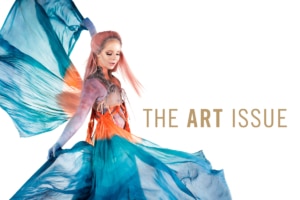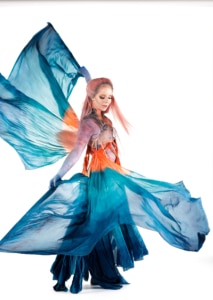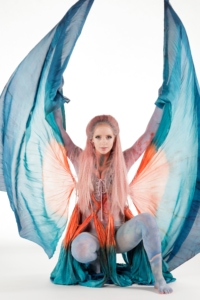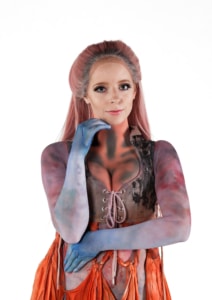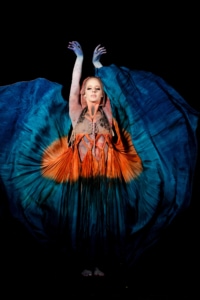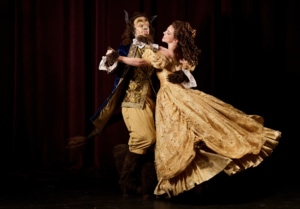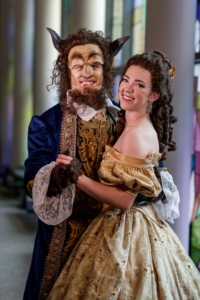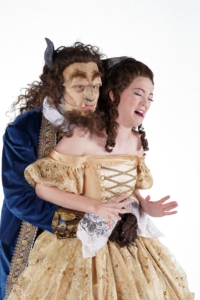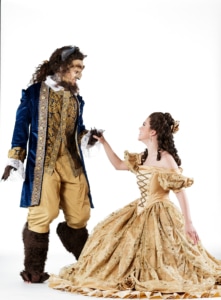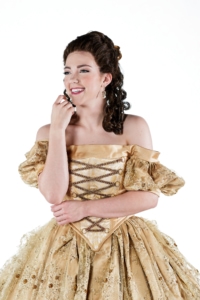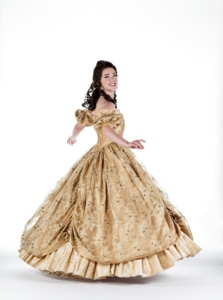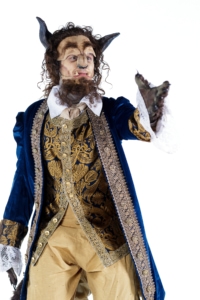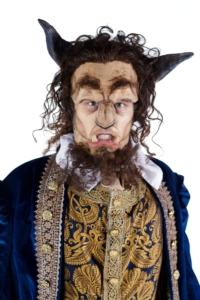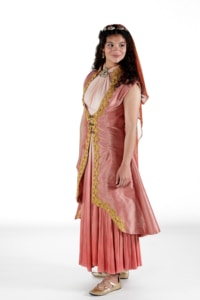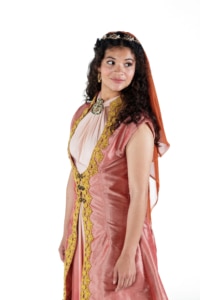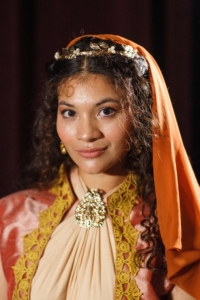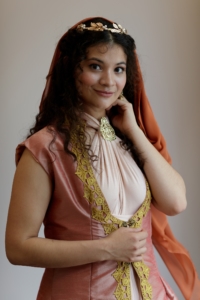Fashion, film and a flair for the dramatics
With alumnae in the industry like Janie Bryant, Emmy Award winner for her work on the HBO series Deadwood and three-time nominee for her work on AMC’s Mad Men, and Antonina Lerch, who worked on Showtime’s popular Dexter and the 2009 Star Trek reboot, Brenau University has built a legacy in costume design. Now, it has the degree program to match.
The Wild West in the 1870s. Hollywood in the 1930s. New York in the ’60s.
They are some of the most iconic moments in American history and fashion, and Janie Bryant has designed them all.
Katherine Jane “Janie” Bryant, the Brenau Academy graduate who attended the Women’s College for a year, is an Emmy Award-winning costume designer for the celebrated HBO series Deadwood. Perhaps best known for her highly acclaimed work on the AMC series Mad Men, she recently designed the costumes for Amazon’s take on F. Scott Fitzgerald’s final and unfinished work The Last Tycoon, and enjoyed the success of the 2017 film adaptation of Stephen King’s It.
Bryant attended Brenau Women’s College her freshman year, after graduating from the Academy and before transferring to Georgia State University. At the time, a career in costume design was not on the table and Brenau didn’t have the degree program – yet.
“I hopped around a lot,” says the Cleveland, Tennessee, native. “I got a lot of pressure to be in the family textile business, which I really didn’t want to do. Then I thought I wanted to study business. But honestly? That was because I wanted to wear great outfits. I just wanted to put on a great Armani suit. You can’t fight who you are, you know?”
This fall, Brenau University will begin enrolling students in its new degree program for a Bachelor of Fine Arts in costuming for film and theater. The major would have been right up Bryant’s alley, but she took a roundabout way into the industry.
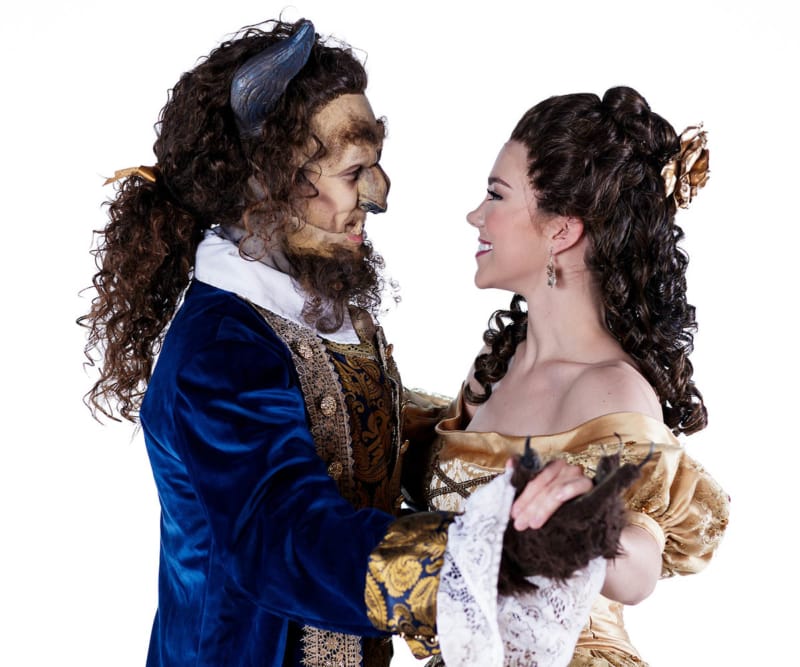
She initially studied drawing and painting at Georgia State but soon realized the work was too solitary for her. “I wanted a job where I could be really social, but I did love to illustrate.”
Her friend told her about the fashion design program at the American College for the Applied Arts, and she immediately changed schools.
“I didn’t tell my parents,” she says. “I lied and said I used my tuition money for Georgia State, but I took that money and applied for the American College. I told my dad afterward, ‘I just wanted to let you know that I took that money and got into art school.’
“That went over really well,” she adds with a laugh. “But you have to follow your instincts and do what is right for you sometimes.”
For Bryant, that instinct began when she was a little girl. She started drawing around age 5, always drawing women and women’s clothing. She made her own Barbie clothes and played dress-up throughout her childhood – really, she says, until she was a teenager.
“My mother sewed,” she says. “My grandmother sewed. My babysitter sewed. I was always around it, and I probably started sewing when I was about 7 and designed and made my first dress when I was 8.”
A new design program
That early interest in design is shared by future and current Brenau students who will benefit from the new degree program, including sophomore Madison Kaufman from Peachtree Corners, Georgia.
Kaufman began sewing at 8 years old and began to “cosplay” – dressing up in the costumes of specific characters – in middle school. With this bit of experience, she was asked as a high-schooler to do costumes for Norcross High School’s production of Cinderella.
“I heard about Brenau and the Gainesville Theatre Alliance from my director, Christina Jundt, (WC ‘13) an alumna of Brenau and the theatre program,” Kaufman says. “I was very close to becoming a film major at Georgia State before I decided on Brenau instead. I knew no matter where I went, I would use my degree for entertainment, so at the time it didn’t really matter if I did theater or film. However, the film industry in Atlanta is growing and growing, and the need for local professionals with the right skill is high right now.”
Bryant agrees and commends Brenau for the new degree, which she says provides just what the industry wants in its next designers. “Costume design in film and television is so completely different from theater,” she says. “It’s a different animal. Most programs have the theater aspect, but they don’t talk about designing for film.
“It’s really important for the program to have that focus on film, which is not to say that theater is not important. But it is such a great service to those students for them to know what design for film and television is all about.”
Pamela Workman, Brenau assistant professor of theater and resident costume designer, says the program is perfectly tailored to the university’s abilities and the growing film industry in Georgia.
The program will consist of existing courses drawn from the university’s programs in theater and fashion design, as well as some new ones.
“We’ve opened a computer lab that is solely for fashion and costume students, and the computers have software that is only relevant to pattern making and how to construct costumes through a specific program,” Workman says. “We also have a huge scanner and printer in there that we’ll be able to print the patterns off so they are lifesize. We can then use those to build a garment.”
The new design laboratory was made possible by Brenau alumna and trustee Antonina Lerch, WC ‘03, who brushed shoulders with Bryant on Mad Men. Lerch also worked on well-known shows such as Dexter and True Blood, as well as movies including Night at the Museum II and the 2009 Star Trek reboot. During her collegiate years at Brenau, Lerch worked with the Gainesville Theatre Alliance as a costumer.
The new lab brings the future of costume design to the Brenau campus. It will allow students to design, organize and store their work, create layouts, design patterns, and correct them in 3D on a custom avatar before any real cutting and building work begins.
“Due to the customized nature of costume design, most professional costume shops in the U.S. have traditionally created costumes and patterns by hand, and that’s how it’s still done by the best costume builders in Hollywood,” Lerch says. “Knowing how to build costumes by hand is important. However, from my experience working in the Hollywood film industry, I have witnessed how this approach can handicap the possibilities in such a fast-paced industry.”
Lerch says most of the program’s building blocks were already in place prior to the addition of the lab, including highly skilled and caring faculty members, ongoing high quality performances, visiting professional guest artists and students hungry to learn and create.
“Since I became a trustee in 2015, I have strongly supported and encouraged Brenau to implement this program and make it official, and I am thrilled and excited that the efforts of many people who worked hard on building it finally came to fruition,” Lerch says. “It seemed like a logical step to offer costume designing education for students in such a rich theater environment.”
Catering to Georgia film
Workman said Brenau’s new coursework will include classes specifically in costuming for both theater and film, fitting given the university’s proximity to Atlanta, which has become a national hub for the film industry.
“Atlanta has probably the biggest film production in the United States at this point,” Bryant says.
According to a 2017 report from Georgia Gov. Nathan Deal’s office, the industry spent $2.7 billion in the state last fiscal year. An annual review by FilmL.A., the official film office of the city and county of Los Angeles, listed Georgia as the No. 1 filming location worldwide. Even Hall County is a popular site, according to the Gainesville Times, which reports more than nine production companies have acquired permits already in 2018.
Mae Allison, a Brenau theater major with an emphasis in musical theater, says she always enjoys seeing the way a garment has been constructed before she performs in it. “Our costumes are honestly amazing,” she says.
Workman agrees, saying Brenau has “one of the best-stocked costume shops in Georgia.” She says the design and construction skills of Brenau students have improved significantly over the last few years, and she credits much of this to costume shop supervisor Aimee Johnson, who came to Brenau two years ago after seven years with Cirque du Soleil in Las Vegas.
“I had a student last year who didn’t know what a needle and thread were,” Johnson says. “By the end of the semester, she was doing emergency repairs backstage.”
Johnson says the costuming curriculum starts with simple costume construction, including all the basic hand stitches used in costuming such as whip stitch and slip stitch.
In the first class, students learn to build a simple garment. As they move up, they learn how to build patterns and sketches, how to turn a sketch into a garment and how to draft patterns using a person’s measurements.
“They have to go through those classes to get to my tailoring class,” Johnson says. “In that class, they learn to do a lot of proper structure, such as what is in a men’s suit. They learn, for example, four different pockets found in suits and vests.”
There are also two design courses in addition to her construction courses, several stage makeup courses and more. The program allows students to tailor their studies to what they want to do in their careers.
“When I was coming through undergrad, you didn’t have this focus within your studies,” says Johnson, who earned her bachelor’s in design and technical theater from the University of Central Florida. “It really lets them have some play and hone it into what they want to go out and do for a living. This undergrad program is genuinely one of the very best I’ve seen.”
A lot of labor
Brenau Window last featured Bryant in its Spring 2008 issue, at which point she had wrapped Deadwood and was in the midst of the Mad Men phenomenon. Bryant says she didn’t realize at the time how iconic the show – and the garments she designed and curated for it – would become. “It was always about getting the work done. It was a show that required a ton of work.”
After Mad Men, she took a year off from costume design. In that year, Bryant did two shoe collections, a dress collection for Black Halo and the uniforms for the Watergate Hotel in Washington, D.C., which she says was “such a fun project.”
“I ended up staying at the Watergate last year when I went to join the Women’s March,” she says. “It was incredible to meet the staff, who told me they always got asked about their uniforms.”
After a year, she returned to costume design for the show Telenovela, which starred and was executive produced by Eva Longoria. “She is an inspiration,” Bryant says of Longoria. “She’s an incredible businesswoman, a powerful activist and just a lovely, fun person.”
An activist herself, Bryant wore black to the InStyle Awards and the Costume Designers Guild Awards this year in solidarity with the Time’s Up and Me Too movements, which address gender disparity and sexual harassment toward women.
“I ended up staying at the Watergate last year when I went to join the Women’s March,” she says. “It was incredible to meet the staff, who told me they always got asked about their uniforms.”
After a year, she returned to costume design for the show Telenovela, which starred and was executive produced by Eva Longoria. “She is an inspiration,” Bryant says of Longoria. “She’s an incredible businesswoman, a powerful activist and just a lovely, fun person.”
An activist herself, Bryant wore black to the InStyle Awards and the Costume Designers Guild Awards this year in solidarity with the Time’s Up and Me Too movements, which address gender disparity and sexual harassment toward women.
When asked if she has faced any gender discrimination or harassment in the industry, Bryant’s immediate answer is “of course.”
“But when it comes to the level of harassment Harvey Weinstein imposed upon those women, that has never happened to me,” she says. “It is entirely unacceptable. It’s abusive. Nobody, man or woman, would ever want to be in that position.
“People have horror stories in Hollywood, but I can honestly say I’ve worked with incredible people,” she adds. “And that’s no coincidence, because if they’re not great, I’m not staying.”
Bryant calls The Last Tycoon, which she completed after Telenovela, “another hard show” that required extensive costuming for an enormous cast.
“I feel really blessed that I have been able to design so many incredible shows,” she says. “I mean, the 1930s in Hollywood? You can’t get better than that except for, you know, maybe the 1960s in New York City.”
The same could be said of her latest film, the 2017 adaptation of Stephen King’s It, for which she was able to combine early experience in horror films with her strength in designing for period pieces.
“It was great to be able to design Pennywise,” she says of the terrifying clown in King’s 1986 horror story. “There were so many period elements in that costume, but I also wanted to have this very organic element to him. Andy [Muschietti], the director, told me immediately that if you’ve read the book, you know that Stephen King describes Pennywise being in a silvery gray. So that’s what I did. It was really about maintaining the integrity of what Stephen King wrote.”
Bryant says she loves designing horror films, because they require “a ton of multiples.” For Pennywise the Dancing Clown, Bryant’s manufacturer built 17 different clown costumes to accommodate the action in the film.
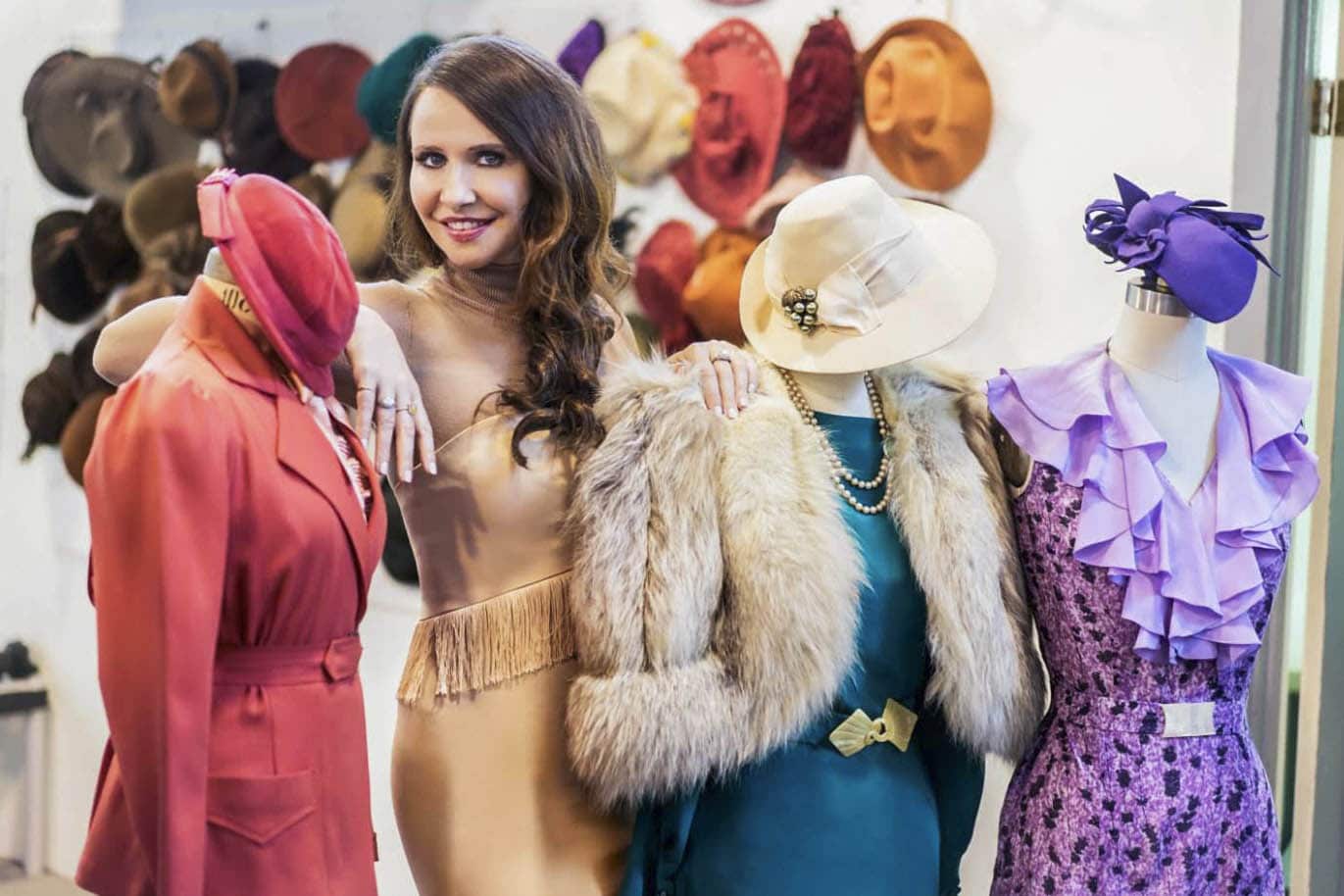
She recently finished 10 months of The Romanoffs, which debuts on Amazon in the fall and brought Bryant back together with several of the Mad Men creators and stars. She also has a new, top-secret collection that will be announced later this year.
Bryant – who enthusiastically recommends daily meditation, reflection or prayer to survive the bustling television and film industry – says costume design is not the career for just anyone.
“It’s a lot of labor,” she says. “It always is. So you have got to love it. And I do.”
- Brenau junior Mae Allison of Lawrenceville, Ga., shows off a siren costume from the Gainesville Theatre Alliance’s production of ‘The Odyssey.’
- Brenau junior Mae Allison of Lawrenceville, Ga., shows off a siren costume from the Gainesville Theatre Alliance’s production of ‘The Odyssey.’
- Brenau junior Mae Allison of Lawrenceville, Ga., shows off a siren costume from the Gainesville Theatre Alliance’s production of ‘The Odyssey.’
- Brenau junior Mae Allison of Lawrenceville, Ga., shows off a siren costume from the Gainesville Theatre Alliance’s production of ‘The Odyssey.’
- University of North Georgia student Chris Hallowes and Brenau’s Lauren Hill, a junior acting major from Flowery Branch, Ga., don costumes from the Gainesville Theatre Alliance’s production of ‘Beauty and the Beast’.
- University of North Georgia student Chris Hallowes and Brenau’s Lauren Hill, a junior acting major from Flowery Branch, Ga., don costumes from the Gainesville Theatre Alliance’s production of ‘Beauty and the Beast’.
- University of North Georgia student Chris Hallowes and Brenau’s Lauren Hill, a junior acting major from Flowery Branch, Ga., don costumes from the Gainesville Theatre Alliance’s production of ‘Beauty and the Beast’.
- University of North Georgia student Chris Hallowes and Brenau’s Lauren Hill, a junior acting major from Flowery Branch, Ga., don costumes from the Gainesville Theatre Alliance’s production of ‘Beauty and the Beast’.
- Brenau junior Lauren Hill as Belle from ‘Beauty and the Beast.’
- Brenau junior Lauren Hill as Belle from ‘Beauty and the Beast.’
- University of North Georgia student Chris Hallowes models the Beast costume from ‘Beauty and the Beast.’
- University of North Georgia student Chris Hallowes models the Beast costume from ‘Beauty and the Beast.’
- Brenau senior acting major Geanna Funes of Calhoun, Ga. as Helen of Troy from the GTA’s ‘The Odyssey.’
- Brenau senior acting major Geanna Funes of Calhoun, Ga. as Helen of Troy from the GTA’s ‘The Odyssey.’
- Brenau senior acting major Geanna Funes of Calhoun, Ga. as Helen of Troy from the GTA’s ‘The Odyssey.’
- Brenau senior acting major Geanna Funes of Calhoun, Ga. as Helen of Troy from the GTA’s ‘The Odyssey.’
